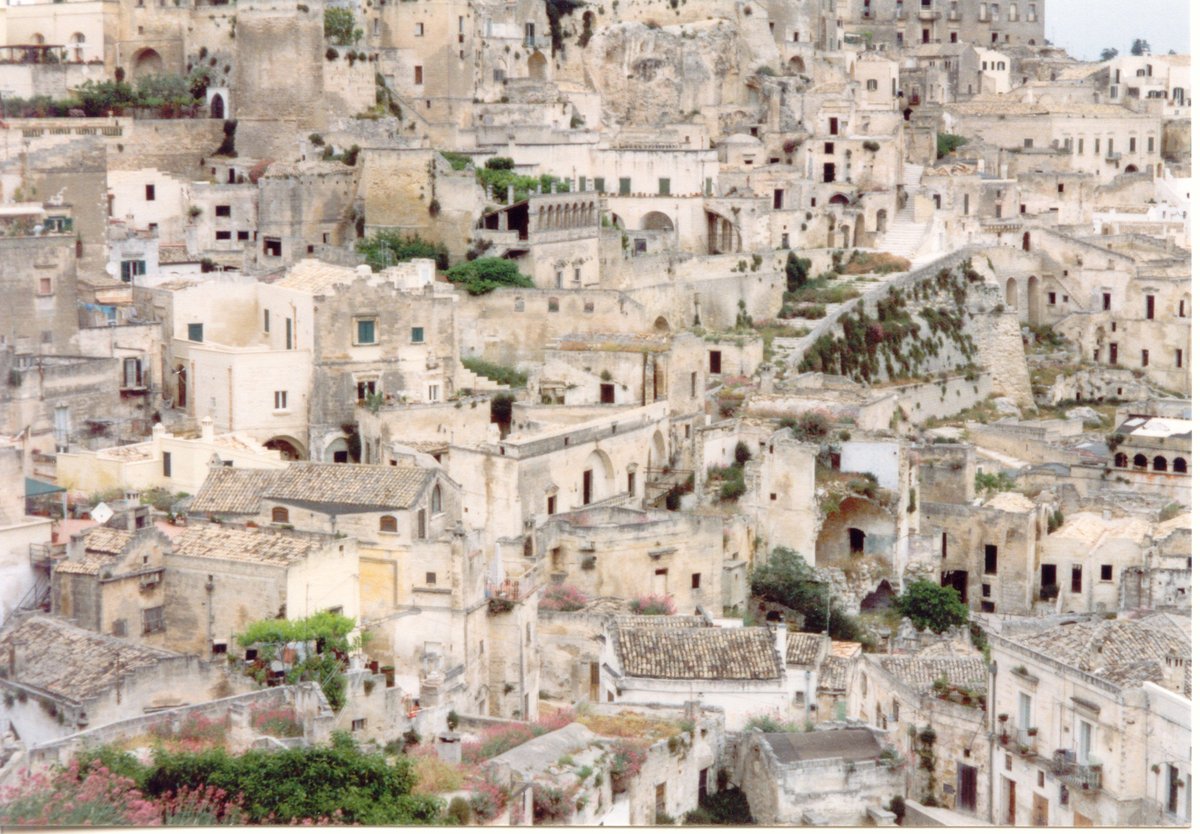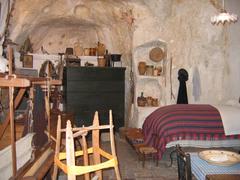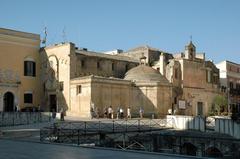
Sassi and the Park of the Rupestrian Churches of Matera: Visiting Hours, Tickets, and Visitor Guide
Date: 15/06/2025
Introduction: Matera’s Timeless Heritage
Nestled in the limestone cliffs of southern Italy’s Basilicata region, the Sassi of Matera and the Park of the Rupestrian Churches present a remarkable journey through human history and ingenuity. Recognized as a UNESCO World Heritage Site since 1993, Matera is home to one of the oldest continuously inhabited urban settlements in the world, tracing human presence back at least 9,000 years. The city’s two ancient districts—Sasso Caveoso and Sasso Barisano—are a labyrinth of cave dwellings, winding alleys, and storied rock-cut churches. These sites are not merely relics but living testaments to resilience, adaptation, and the enduring spirit of community.
Today, Matera’s unique urban landscape, vibrant traditions, and atmospheric cave hotels invite travelers to experience a city reborn from hardship into a beacon of cultural preservation. This comprehensive guide details Matera’s extraordinary history, key sites, practical visitor information, ticketing, accessibility tips, and insider advice for an unforgettable visit.
For further reading, explore trusted sources such as Never Ending Voyage, The Urge to Wander, and the official Matera Welcome website.
Table of Contents
- Historical Background and Evolution
- Sassi Districts: Sasso Caveoso & Sasso Barisano
- The Park of the Rupestrian Churches
- Visiting Hours, Tickets, and Accessibility
- Key Sites and Experiences
- Guided Tours, Tips, and Best Photo Spots
- Unique Stays and Local Cuisine
- Getting There and Orientation
- Practical Tips and FAQs
- Conclusion and Resources
Historical Background and Evolution
From Prehistory to the Middle Ages
Archaeological evidence situates Matera among the world’s oldest cities, with occupation dating to the Paleolithic era (Never Ending Voyage; Matera Welcome). Early inhabitants carved simple caves for shelter, gradually developing a sophisticated urban environment. The city flourished during the Neolithic and Bronze Ages, expanding its architecture and agricultural base. Under Roman influence, Matera benefited from its strategic location between major trade routes.
In the Middle Ages, the Sassi districts took shape, with homes stacked along labyrinthine alleys, stairways, and terraces (The Urge to Wander). The Civita, the city’s fortified heart, rose between the Sassi, crowned by the 13th-century cathedral.
The Rupestrian Churches: Spiritual and Artistic Heritage
Between the 8th and 13th centuries, Basilian monks fleeing Byzantine persecution established monastic communities, carving over 150 rupestrian (rock-cut) churches into the cliffs (Never Ending Voyage; Shuttle Matera). These churches, adorned with Byzantine frescoes and unique iconography, reflect a blend of Eastern and Western Christian traditions.
Decline, Abandonment, and Revival
By the 19th and early 20th centuries, Matera faced severe poverty. Overcrowding and unsanitary conditions led to its infamy as the “shame of Italy” (The Urge to Wander). In the 1950s, mass relocations left the Sassi deserted and crumbling. Decades later, local advocacy and restoration efforts led to Matera’s revival. UNESCO recognized the Sassi and the Park of the Rupestrian Churches in 1993 as “the most outstanding, intact example of a troglodyte settlement in the Mediterranean region” (UNESCO).
Matera’s Modern Renaissance
Designated European Capital of Culture in 2019, Matera has attracted international attention and tourism investment (Never Ending Voyage). The city’s cave dwellings now house boutique hotels, restaurants, and museums, serving as a model for sustainable heritage preservation.
The Sassi Districts: Sasso Caveoso and Sasso Barisano
The Sassi are divided into two main districts:
- Sasso Caveoso: Maintains a more rugged, ancient appearance, with many caves preserved in their original state.
- Sasso Barisano: Features more restored homes, artisan shops, restaurants, and boutique cave hotels (themarveloustravelers.com).
Both districts are best explored on foot, as their pedestrianized lanes, stairways, and terraces reveal hidden courtyards and striking architecture (traveltoitalyguide.com).
The Park of the Rupestrian Churches (Parco della Murgia Materana)
Across the Gravina ravine lies the Parco della Murgia Materana, an 8,000-hectare area home to over 150 rock-hewn churches and prehistoric caves (medium.com). These churches, many with remarkable frescoes, were carved by monastic communities between the 8th and 13th centuries.
Notable Churches:
- Crypt of the Original Sin: Known as the “Sistine Chapel of Rupestrian Churches,” with extraordinary Old Testament frescoes.
- Madonna delle Virtù and San Nicola dei Greci: Renowned for evocative frescoes.
- Santa Maria de Idris: Offers panoramic city views.
- San Pietro Barisano: The largest rupestrian church in Matera.
- Santa Lucia alle Malve: Features 13th-century frescoes (alongdustyroads.com).
Most churches are accessible via scenic hiking trails, blending history with natural beauty.
Visiting Hours, Tickets, and Accessibility
Sassi Districts
- Open year-round: No general entry fee; pedestrian access at all times.
- Best explored: Daylight hours (8:00 AM to sunset) for safety and maximum enjoyment.
- Some private museums and cave accommodations may require advance booking.
Park of the Rupestrian Churches
- Park access: Free; open from 9:00 AM to 6:00 PM.
- Some churches require tickets (typically €3–€7, e.g., Crypt of the Original Sin).
- Tickets available: On-site or via select tour operators.
Major Museums and Sites
- Casa Noha: 10:00 AM–6:00 PM (closed Mondays), entry ~€4.
- Palombaro Lungo: 9:00 AM–5:00 PM, entry ~€3.
- Matera Cathedral: 9:00 AM–7:00 PM, free entry.
- Sassi in Miniatura: 9:00 AM–7:00 PM, entry ~€2.
Note: Always check opening times and ticket availability, as they may change seasonally.
Accessibility
- The Sassi’s terrain is steep and uneven, presenting challenges for wheelchair users and those with mobility issues.
- Some main roads (e.g., Via Fiorentini), Matera Cathedral, and Casa Noha offer partial accessibility.
- Consult local tourism offices or guides for adapted options.
Key Experiences and Must-See Sites
Guided Tours
- Walking tours (2–3 hours) are highly recommended for insight and access to restricted sites.
- Thematic tours—focusing on rupestrian churches, local cuisine, or photography—are available (Wanderlust Storytellers).
- Book in advance, especially during high season.
Panoramic Viewpoints
- Belvedere di Murgia Timone: Offers iconic views of the Sassi and city skyline.
- Belvedere Piazza Pascoli and Convent of Saint Agostino: Other excellent vantage points.
- Early morning and sunset provide the best light for photography.
Unique Stays
- Many cave dwellings have become boutique hotels and B&Bs, offering atmospheric, modern accommodations (traveltoitalyguide.com).
- Book early, especially in spring and autumn.
Local Cuisine
- Sample orecchiette pasta, Matera bread (Pane di Matera IGP), and lamb dishes.
- Restaurants in the Sassi often occupy historic caves, providing unique dining experiences (traveltoitalyguide.com).
Getting There and Orientation
Access
- By Train: FAL line from Bari Centrale (about 1.5 hours; not Trenitalia) (Walks of Italy).
- By Car: Parking is outside the historic center; no cars permitted within the Sassi (Italia Like a Local).
- By Bus: Direct buses from Bari, Naples, and regional cities.
Navigating Matera
- The Sassi are best explored on foot. Wear sturdy shoes and be prepared for elevation changes (Walks of Italy).
- Maps are available, but part of the experience is wandering the labyrinthine streets (Italia Like a Local).
Practical Tips for Visitors
- Best Time to Visit: Spring (April–June) and autumn (September–October) offer mild weather and fewer crowds (Italia Like a Local).
- Clothing: Dress in layers; summers are hot, winters can be cool.
- Water: Carry a refillable bottle, especially in summer.
- Stay Duration: Plan at least two to three days to fully explore the Sassi, museums, and surrounding park (traveltoitalyguide.com).
- Safety: Matera is safe for solo travelers; take standard precautions, especially at night (travellingking.com).
- Respect: Many churches are active places of worship; dress modestly and follow photography rules.
Frequently Asked Questions (FAQ)
Q: What are the main visiting hours?
A: Most sites open daily from 9:00 or 10:00 AM until 5:00–7:00 PM, with some seasonal variation. The Sassi districts are accessible at all hours but best explored during daylight.
Q: Where do I buy tickets?
A: Tickets are available on-site or online for museums and churches. Combination tickets and guided tours are recommended for convenience.
Q: Is Matera accessible for visitors with disabilities?
A: Some areas (main roads, select museums) are partially accessible, but most of the Sassi and rupestrian churches have steep and uneven paths.
Q: Are guided tours available?
A: Yes, numerous walking and thematic tours are available and provide valuable context and access to restricted sites.
Q: When is the best time to visit?
A: Spring and autumn offer the most pleasant weather and manageable crowds.
Q: What nearby attractions should I visit?
A: Explore the Park of the Rupestrian Churches, Altamura, Gravina, and Alberobello for a broader southern Italy experience (Italia Like a Local).
Conclusion
Matera’s Sassi and the Park of the Rupestrian Churches stand as a testament to human adaptation, creativity, and cultural continuity. From ancient cave dwellings and rock-cut churches to atmospheric hotels and vibrant festivals, Matera offers an experience unlike any other. With thoughtful planning—considering visiting hours, tickets, and accessibility—you’ll be prepared to immerse yourself in this UNESCO marvel. Download the Audiala app for interactive maps, ticketing, and audio guides to enrich your journey.
Sources
- Never Ending Voyage
- The Urge to Wander
- Matera Welcome
- Leggere i Siti UNESCO
- Shuttle Matera
- Earth Trekkers
- Italia.it
- Walks of Italy
- Wanderlust Storytellers
- Italia Like a Local
- World Heritage Sites
- The Road Reel
- Its All Trip To Me
- Italy Magazine
- themarveloustravelers.com
- traveltoitalyguide.com
- medium.com
- alongdustyroads.com
- lotuseaters.travel
- adventuresbytrain.com
- travellingking.com


